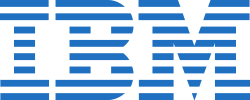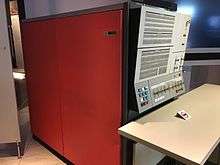IBM System/360 Model 30
 | |
|
IBM System/360 Model 30 at the Computer History Museum | |
| Manufacturer | International Business Machines Corporation (IBM) |
|---|---|
| Product family | System/360 |
| Release date | April 7, 1964 |
| Introductory price | $133,000+ |
| Discontinued | June 22, 1970 |
| Memory | 8 - 64 K Core |
| Website | Official website IBM Archives |
The IBM System/360 Model 30 was a low-end member of the IBM System/360 family. It was announced on April 7, 1964, shipped in 1965, and withdrawn on October 7, 1977.[1]
History
The Model 30 was a popular IBM mainframe announced in 1964 across the world as the then least powerful of the System/360s – the first line of computers in the world to allow machine language programs to be written that could be used across a broad range of compatible sizes. It was the smallest model that had the full System/360 instruction set (unlike the Model 20) and served as a stand-alone system, communications system or as a satellite processor of a larger system.[1]
The first delivery of the 360/30 was in June 1965 to McDonnell Aircraft.[2]
Along with the 360/40, these were the two largest revenue producing System/360 units.[2]
Models

Four models[3] of the 360/30 were initially offered.[4] They vary by the amount of core memory with which the system was offered. The C30, D30, E30 and F30 were respectively configured with 8K, 16K, 32K and 64K of core memory.[4]:Fig.5,p.9
It was little publicized that there were two versions of the Model 30,[4]:pp.2,8,9 known (on the rare occasions when they were distinguished at all) as the 30-1 and the 30-2. The original 30-1 had a 2.0 microsecond storage cycle. Later, after the first 1000 30-1 were shipped,[2] it was replaced by the 1.5-microsecond 30-2, although the 30-1 was silently retained in the sales catalog. The two were cosmetically different; the 30-1 looked like other System/360 models, with indicator lamps exposed on the front panel and labeled, but the 30-2 took a retrograde design step, putting the lights behind a stencil, as they had been on pre-360 machines like the IBM 1401.
The (faster) 30-2 had an additional model, DC30, with 24K of memory.[4]:Fig.4,p.9
The 7th edition of IBM System/360 Basic Operating System Programmer's Guide, dated September 1967, lists first among major changes support for "an intermediate storage size (24K) for System/360 Model 30."[5]
96K upgrade
In response to competitive pressures, IBM introduced a memory upgrade option, allowing 96K on a 360/30.[6] It seems, based on the system's front panel, that a provision for supporting more than 64K had been pre-planned.[7]
Basic Features
The CPU used an 8-bit microarchitecture with only a few hardware registers; everything that the programmer saw was emulated by the microprogram.[8][9] Handling a 4-byte word took (at least) 6 microseconds, based on a 1.5 microsecond storage access cycle time.[8]:pg.1–4
System configuration
A typical, early Model 30 system consisted of:[10][11]
- IBM 2030 Central Processing Unit (64k storage)
- with or without IBM 1401 System emulation feature
- IBM 1052 Console
- IBM 1442 Card Reader/Punch
- IBM 1403 Printer
- IBM 2401 Tape Drive (x 2)
- IBM 2841 DASD (disk) Controller
- IBM 2311 Disk Drives (x 2)
- Using IBM 1316 Disk Pack
System software
Operating System choices:
- BPS - Basic Programming Support
- BOS - Basic Operating System
- TOS - Tape Operating System
- DOS - Disk Operating System
BPS (Basic Programming Support) did not require a disk drive or even a tape drive. It was introduced in 1965, and has been described[12] as "primarily a set of utilities and compilers (that) existed on cards only."[12]:pages 10,18
BOS (Basic Operating System) required a disk drive, but, like BPS, could run on the smallest 360/30, the 8K model C30.[5]:pp.9,10
The minimum memory needed to run DOS or TOS was 16K.
TOS (Tape Operating System), as the name suggests, required a tape drive. It shared most of the code base [13][14] and some manuals[15][16] with IBM's DOS/360 and went through 14 releases. TOS was discontinued [17] when disk drives [18] became more affordable.[19]
DOS (Disk Operating System) was a popular choice for the 360/30.[20] [21][22][23]
Amazingly[24] the smaller BOS had a Spooling system for queued printing, whereas DOS did not[12]:page 18 until the arrival in the late 1960s of "an add-on component called POWER."[12]:page 16
Programming languages
Programming was mostly in the COBOL, RPG and Assembler languages for the commercial applications that were the predominant uses of this computer, but Fortran could also be used for the scientific and engineering applications. COBOL programs for other computers could be run after recompiling on the System/360, except the input/output sections had to be re-written to relate to the System/360 devices through the DOS/360 DTF (Define the File) macros.
Compatibility features
The ability to continue running programs designed for earlier systems was crucial to selling new hardware.[25] Although the instruction set of System/360 was not backward compatible with earlier systems,[26] IBM provided emulators for the earlier systems.
IBM 1400 series emulation
With the additional Compatibility Feature hardware and Compatibility Support software under DOS/360, the IBM 1401/1440/1460 object programs could be run in the emulation mode, with little or no reprogramming.[27] Many installations included the compatibility feature, allowing older programs to be run.
IBM 1620 emulation
Although the 360/30 could be configured to emulate an IBM 1620,[4]:p.11 two factors made it less crucial than the above IBM 1400 series emulation:
- The IBM 1130 was the preferred successor to the IBM 1620.[28][29]
- Fortran accounted for a significant part of how the 1620 was used,[30] and IBM 1620 Fortran programs could be converted to run on System/360.
Other
- The system was designed by IBM's General Systems Division in Endicott, New York, and manufactured in Endicott and other IBM manufacturing sites outside of U.S.
- The Endicott group built a CCROS (Card Capacitor Read-Only Store) that was cheaper than the Hursley proposed TROS and installed it in the Model 30s.[2]
See also
- IBM System/360 Model 20
- IBM System/360 Model 22
- IBM System/360 Model 25
- IBM System/360 Model 40
- IBM System/360 Model 44
- IBM System/360 Model 50
- IBM System/360 Model 65
- IBM System/360 Model 67
- IBM System/360 Model 85
- IBM System/360 Model 91
References
- 1 2 "IBM Archives: System/360 Model 30". IBM. Retrieved 16 August 2016.
- 1 2 3 4 Pugh, Emerson W.; Johnson,, Lyle R.; Palmer, John H. (1991). IBM's 360 and early 370 systems. Cambridge, Mass.: MIT Press. ISBN 9780262161237.
- ↑ Lower case "M"
- 1 2 3 4 5 IBM System/360 Model 30 Functional Characteristics (PDF). August 1971. GA24-3231-7.
- 1 2 IBM System/360 Basic Operating System Programmer's Guide (PDF). IBM. September 1967. C24-3372-6.
- ↑ Historical Note: A posted submission to Ed Thelen's 360/30 writings (http://ed-thelen.org/comp-hist/ibm-360-30.html) signed LEONARD.BEARES.ctr (at) disa.mil (December 2005) indicated that, in response to a 128K offering by a small company, IBM actually introduced an upgrade, allowing 96K on a 360/30. BEARES noted that this allowed hour-plus tape/disk-based sorts to be done in-core in minutes.
- ↑ http://www.ljw.me.uk/ibm360/links has an entry named Glenn's Computer Museum (http://www.glennsmuseum.com/ibm/ibm.html) that has the following annotation: note that this front panel has indicators for extra address bits to allow more than 64k main storage
- 1 2 Field Engineering Theory of Operation, 2030 Processing Unit, System/360 Model 30 (PDF) (Fifth ed.). IBM. June 1967. Y24-3360-1.
- ↑ Model 30 Microprogramming Language (PDF). IBM.
- ↑ IBM System/360 Model 30
- ↑ Endicott Chronology
- 1 2 3 4 Dave Morton (April 2015). "IBM Mainframe Operating Systems: Timeline and Brief Explanation For the IBM System/360 and Beyond" (PDF).
- ↑ http://bitsavers.trailing-edge.com/pdf/ibm/360/bibliography/GA22- 6822-16_System_360_System_370_Bibliography_Jul71.pdf
- ↑ Per pages 39/TOS and 40/DOS, each had both a 6K and and 8K Supervisor - RESIDENT CODE. This is a lot of code; even on OS/360 some code that was NON-resident was made to fit into 4K chunks. To have maintained FOUR sets of parallel code would have been error prone.
- ↑ "IBM System/360 Disk and Tape Operating Systems Concepts and Facilities" (PDF). October 1970. GC2ij-5030-8.
- ↑ "DOS and TOS Utility Programs" (PDF). August 1973. GC24-3465-8.
- ↑ https://www.mail-archive.com/ibmvm (at) listserv.uark.edu/msg24371.html
- ↑ http://ibm1130.blogspot.com/2013/02/highlighting-similar-project-36030.html
- ↑ Computerworld,Sept.5,1977,p.40 - quotes an IBM task force report that referred to "price alone rather than by price/performance."
- ↑ Of those 360/30 and 360/40 machines still around in 1981/being replaced by 4300 systems, a Computerworld survey showed that DOS was what they ran/had run, May 25, 1981, p. 26
- ↑ http://www.edwardbosworth.com/My3121Textbook_HTM/MyText3121_Ch03_V01.htm
- ↑ http://ed-thelen.org/comp-hist/ibm-360-30.html
- ↑ http://www.highersystems.co.uk/ibm_360_30.html
- ↑ The source cited prefixes its statement with "Amazing fact:"
- ↑ Capers Jones. The Technical and Social History of Software Engineering. ISBN 0133365891.
- ↑ Computerworld, April 24, 1989, page 1
- ↑ IBM System/360 Disk Operating System 1401/1440/1460 Emulator Programs: Compatibility Support/30 & /40 (PDF) (Third ed.). IBM. February 1969. C27-6940-2.
- ↑ Edwin D. Reilly (2003). Milestones in Computer Science and Information Technology. ISBN 1573565210.
- ↑ Dan Ryan. History of Computer Graphics. ISBN 1456751158.
- ↑ Daniel N. Leeson; Donald L. Dimitry (1962). Basic Programming Concepts and The IBM 1620 Computer. Holt, Rinehart and Winston.
External links
- Official website IBM archives
